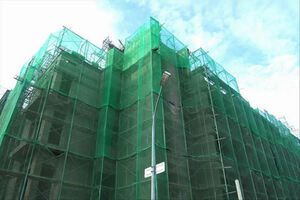Safety nets on construction sites: Types of Systems
Posted By Shrink Wrap
Body
Legislation has given fundamental importance to safety nets as elements of collective security, but which are the most important systems?
Safety nets on construction sites: Types of Systems
There are different types of safety net systems, each with its own characteristics that work best at different times.
Type V Safety Nets
This form of collective protection is generally used during the execution of reinforced concrete structures. It is initially installed on the first floor, and is raised as the work progresses.
This system is installed fundamentally in order to protect the operators who carry out work on the formwork edges, since it completely closes the work perimeter.
The main elements that make up the type V safety net system are logically the net and the davit (fork), although the tying rope, the connecting rope and the anchors must also be included as auxiliary elements.
When disassembling this type of system, the work must always be carried out behind the protections and if it is not possible to work in this way, it will be necessary to work hooked to a fixed point.
Safety Nets Type S
It is a safety net system with a perimeter rope defined by the UNE EN 1263 standard and specifically designed for horizontal use.
The Type S Safety Net system is made up of a network delimited by its perimeter rope and the auxiliary elements that complete the system, such as the tying rope, connecting rope, steel cables with hooking and tensioning devices, and carabiners. .
It is generally used in constructions such as metal structures, wooden structures, bridges and viaducts or precast concrete. They are usually used during the construction process of industrial buildings or when repair, maintenance, etc. are carried out. since its main objective is to protect the operators who are carrying out their work on the roof.
The assembly must be carried out using lifting platforms, scaffolding, ladders or accessing the profiles that make up said structure. For the disassembly it will be necessary to use the same commented elements aided by auxiliary elements.
Safety Nets Type U
These U-type safety net systems have their characteristics determined by the UNE EN 1263-1 standard and it is basically a safety net that is attached to a support structure for vertical use.
Before the appearance of the UNE 13374 standard that refers to provisional edge protection systems, there were different standards that were responsible for determining the criteria to follow with these systems, but the appearance of this standard has more clearly determined the minimum conditions to be met, all for the benefit of worker safety.
Safety Nets Type T
Type T safety net systems are tray-type metal structure systems that support a safety net. They are initially installed on the first floor and are raised as the heights advance.
As for the assembly, it is carried out by the same operators who are executing the structure or personnel specialized in the assembly of safety nets. The panels are joined together and placed on the metal supports (trays) that are attached to the slab by means of clamps or similar elements.
They have an interesting advantage and that is that their horizontal position is much less exposed than the vertical to windy conditions, thus avoiding variations in their placement, thus allowing a greater distance from the network to the facade, managing to cover a greater space and better protect workers in the event of a vacuum fall.
Safety Nets under wrought
Safety nets under slabs are a collective protection that aims to cover the risk of falling to different levels during the process of placing panels and boards in the horizontal formwork and at the same time protect the worker in the event of any breakage. of those boards once installed. There are two types:
Disposables (System A):
It is a system installed horizontally and continuously from the top of the pillars above the structure that makes up the formwork mechanism. The net is fixed to the structure, compressing it between the boards themselves and the longitudinal and cross-sectional elements of the meccano, and the process is carried out at the same time that the boards are placed.
Recoverables (System B):
It consists of a safety net with a perimeter rope that is attached to the structure of the horizontal formwork mechanism, in this case with the props that support it by means of anchors and resistant elements so that its installation materializes in the closest possible position to the laying surface of the formwork boards.
Perimeter Enclosure Safety Nets
It is a safety net system that, unlike the previous ones, does not stop falls but rather prevents them since it is a movement restriction system. It is used to protect workers from possible falls in the building envelope on floors that have already been stripped and sometimes remain installed even until the window is installed. It is a very useful system to protect stairs, elevator shafts, light wells, etc. These types of nets are also manufactured with anti-debris to prevent particles from falling.
It is recommended to use it at the same time as the V-type systems for stripping the lower level to prevent people from falling or formwork elements (props, shoring, braces, etc…) into a vacuum.











Comments